
The lasting memory of a game at Harlech is the imposing castle standing guard atop the cliffs overhanging the links. When built in the late 13th century during Edward I’s (yes, the one and same Hammer of the Scots) conquest and colonization of Wales, the castle stood much closer to the Irish Sea. Not long after Harlech castle was completed Edward invested the title Prince of Wales for his son who would later become Edward II. An important defensive castle for the next 450 years, Harlech was the last fortification to surrender to the parliamentary forces of Oliver Cromwell. Harlech was merely one of five castles in Edward’s Ring of Stone. The other four are Flint, Conwy, Caernarfon and Beaumaris. Some regard the castles as the tale of a King using stone to impose his will over the Welsh and others see the castles as symbols of rebellion, proof in stone of the effort Edward exerted to control the Welsh. Which version of the truth to believe I leave to the reader to decide. However, there is no doubting the architectural significance or the impressive nature of these castles.
Formed in 1894, Royal St David’s gained royal patronage in 1908. It would seem this Welsh outpost was staging its own rebellion against the crown when the club advertised for new members of Royal St David’s in 1901! Indeed, the club was so keen it persuaded the R&A and Royal Liverpool to send golfers to Harlech for an Autumn Open held in 1894 when the incomparable John Ball claimed first place with a score of 152. Harlech is well known for hosting important events, mainly of the amateur variety. Perhaps the most worthy winner of all was Harold Hilton. He and John Ball were the bedrock of Hoylake and often competed in Harlech events which included the Town Bowl won by Hilton in 1901 & 1902. Both golfers were supreme competitors who won the Amateur on multiple occasions and the Open at least once. It was Harold Hilton, however, who made the long journey to The Apawamis Club in Rye, NY. Hilton beat a good field including F Herreshoff in the final on the 37th hole to win the 1911 US Amateur and claim the Havemeyer Cup. In all, Hilton won four Amateurs, two Opens, one US Amateur and a slew of important club events, making him what I believe to be the most underrated male golfer in history.
Map by P Dickinson. Much like Aberdovey, the routing is squeezed in the middle to form a bow tie shape.

This must have been my fifth visit to Harlech over the last 25 years or so. After reading what many people on this site wrote I was beginning to doubt myself. All is well with my memory! The course impressed me as much as on previous visits. What I walked away with today was an immense appreciation for the bunkering. Some of the variety has been lost with the new work, but this is balanced by better drainage and a more cohesive aesthetic. That said, I do hope the 17th is revisited. I am not convinced by the new configuration of bunkers.
Harlech Castle hovers behind the tee of an uneventful opening hole. That said, there have been significant alterations to the course in the form of new bunkers (some with different locations) and more short grass area around the greens. The first green is evidence of the new presentation.

The second comes back toward the house in the oblique manner of a severe dogleg left around new bunkers. I have a soft spot for unappealing land used to good effect. Greens tucked into corners is one example of such as seen below.
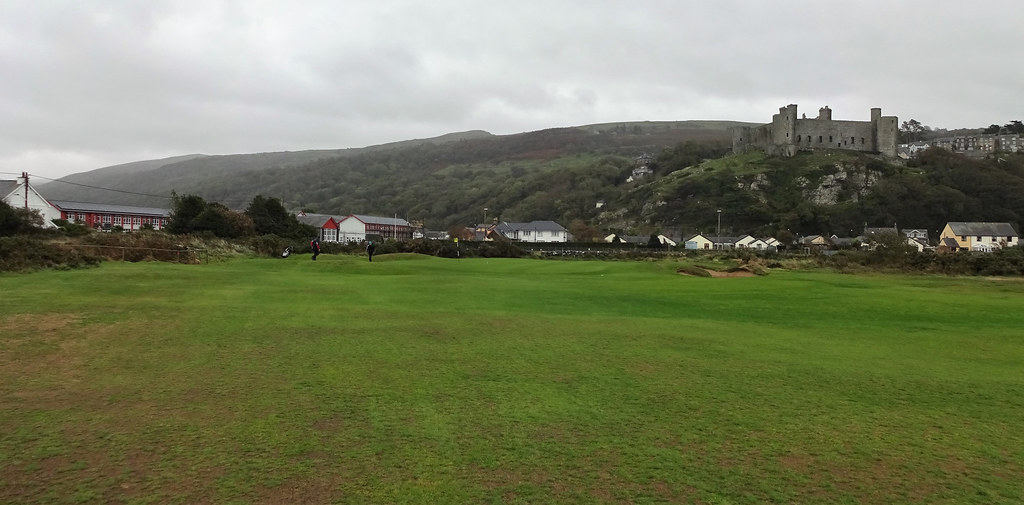
The 3rd goes back out along the fence line and is quite a tight driving hole for this 450ish yard par 4 - one of many back breaking two shotters on this par 69 layout. In days gone by, the green used to be around the corner to the right, near the old 4th tee. It called for a daring second shot over OOB to reach this three-shot hole in two. This is one of the relatively few routing changes from the course Finch-Hatton and the Secretary, Mr More, laid out in 1894! P Dickinson sketch of the hole.

The terrain is no different than the first two holes. In fact, the terrain is largely flat until the 11th and that is the likely reason why Harlech is a bit polarizing. For those who know the course fairly well, great respect is afforded Royal St David's because the course doesn't suffer fools gladly. It is interesting to compare the bunker styles.
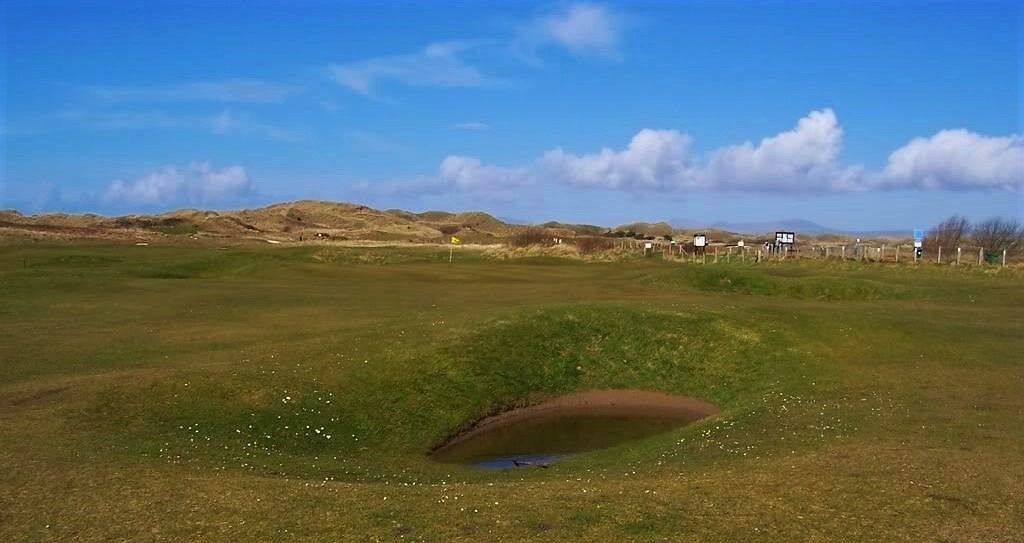
The green runs away from play.

The 4th is the first of five par 3s and its a good one. When G Campbell altered the 3rd shortly after WWII, he built a new 4th. The green rests on a slight table and runs hard from left to right. As is often the case on links, things seem fine until you get behind your ball and realize that getting close with a chip is near on impossible. It looks gentle enough, but don't miss this tee shot left.


5 through 10 are all solid, makes sense golf covering the morfa scattered below the castle. The 5th.

7 & 8 are reachable par 5s, but most likely only one can be reached on the same day because they run in opposite directions. The kicker is these are the only three-shotters on the course so the golfer must take advantage. The short 9th and very long, par four 10th run parallel to the beach. #9
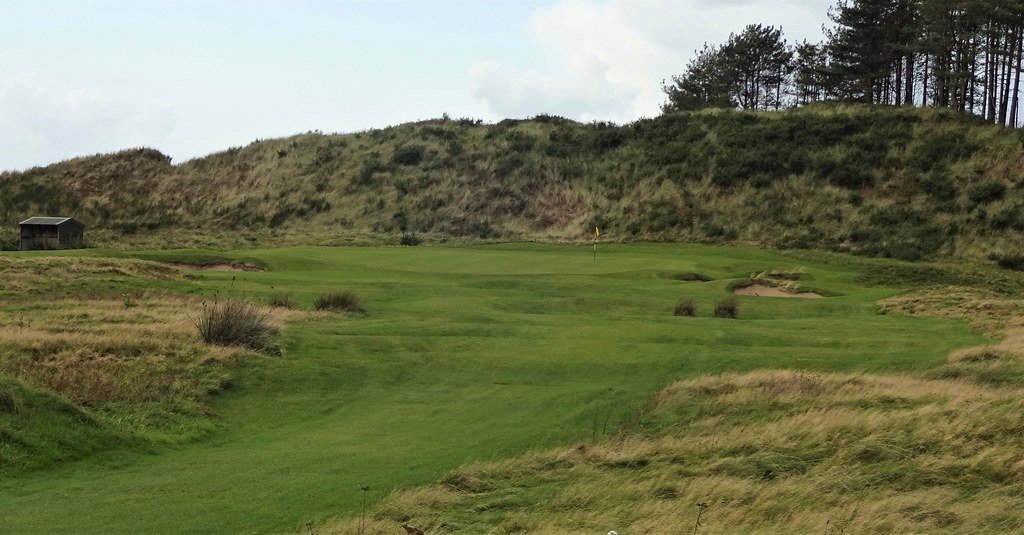
Thinking on it, the par 3s are quite a good set. The 11th offers a bit of a respite as its quite short, but still plays tricky over a front bunker.

Navigation between the bunkering for the drive on #12 is required - no easy task in a harsh crosswind.


Another tough two shotter, the 13th likely requires two woods to get near the green in two. The approach is tricky with wind off the right, very harsh rough on this wing and a footpath !

Bunkers protect the right side of the green and the putting surface slopes from the right. Previous bunkers.

New bunkers.
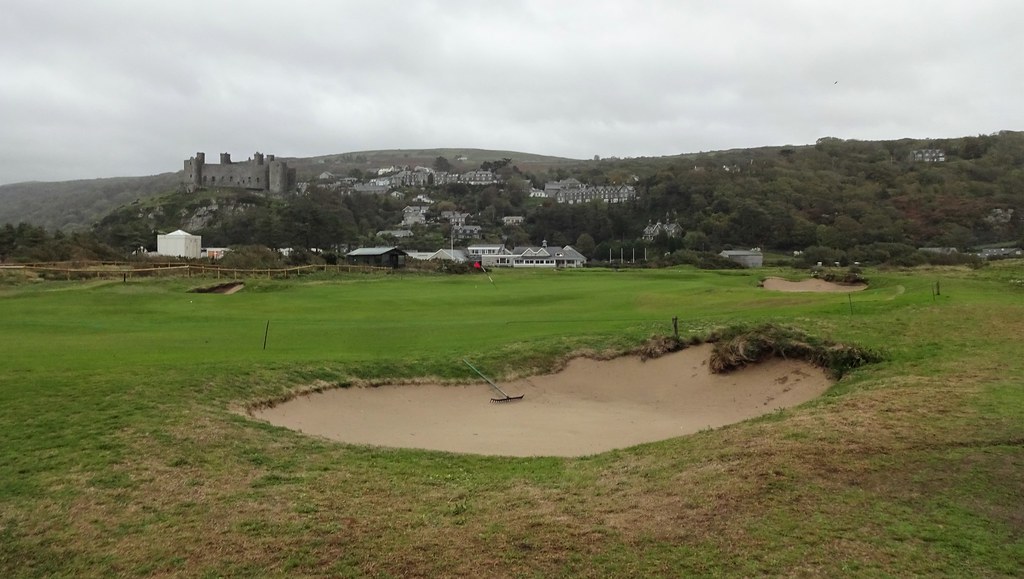
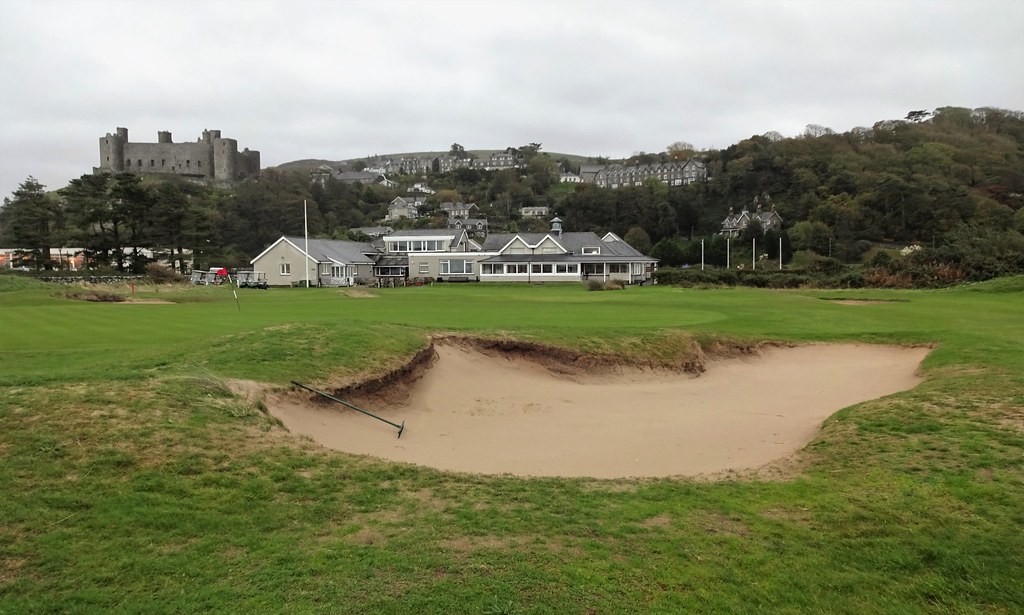
Even some of the par 3s take some hitting to reach. In these conditions I hit driver on the 14th, an obscured shot over a rough laden flat area. The area was recently cleared out making the carry far less harsh. In the old days there was the famous Castle Bunker to be carried which I believe was housed in a large mound.

The 15th is no easier...two woods were required. The drive is a classic bite off as much as one dare type. The approach is often blind down to a semi punch bowl. If there is a signature hole at Harlech, #15 is it.
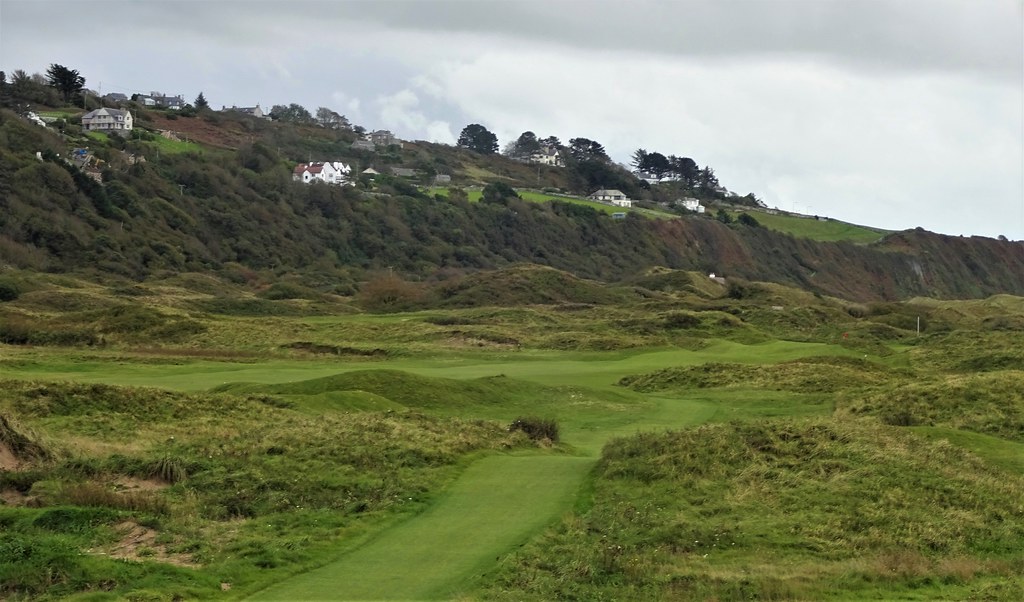


A look at the green from the 16th tee.
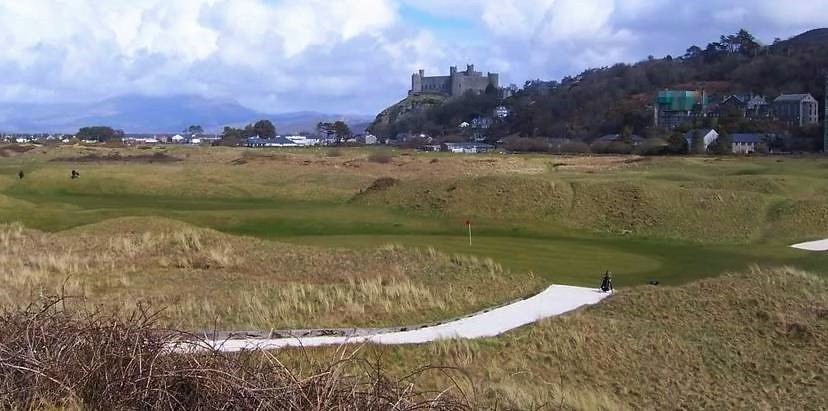
Harlech's purple patch continues as the the 16th offers the golfer the only glimpse of the sea, but some scrambling is required. This is a wonderful driving hole with a humpback fairway and a double layer of cross bunkers.

The 17th has been altered once again. The shape remains the same, but the bunkering has been changed. I still like the hole, but I am not convinced it is better than the previous version. Previously.
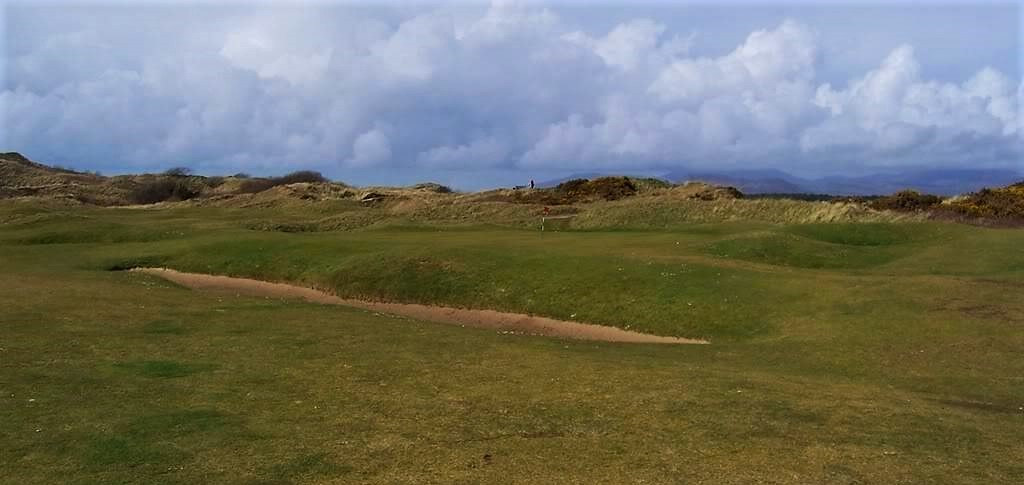
Now. I am not convinced by the little mound blocking the small pot bunker.

Atop the mound.
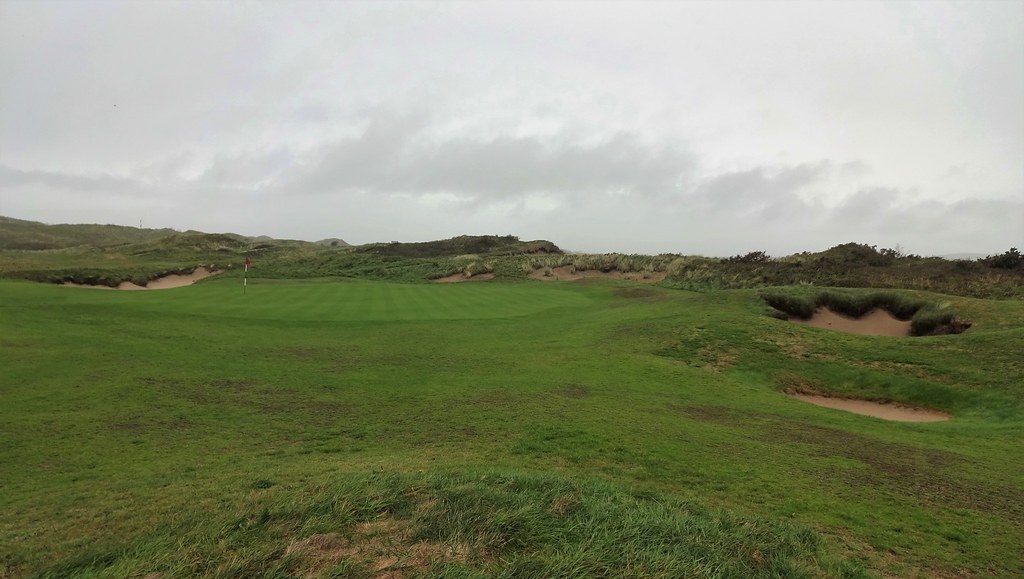
The course finishes with an undistinguished par 3 with a great view of the castle and house.


Despite the lackluster 18th, Harlech remains a grand day out with much to offer the visiting golfer, including the All Wales 15th. The links offers a stiff, but not an overbearing challenging even if much of the course is flat and over turf which often impersonates the links variety. There can be few better experiences than playing Harlech and Aberdovey over a weekend with a stay in the dormy house. 2019
Ran's Review.
http://golfclubatlas.com/courses-by-country/wales/royal-st-davids-golf-club/Happy Hockey